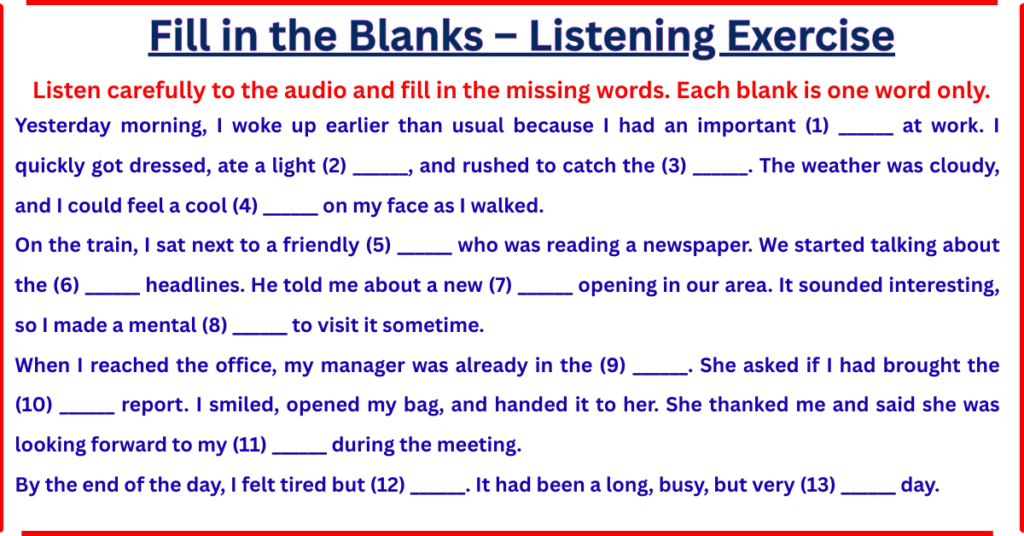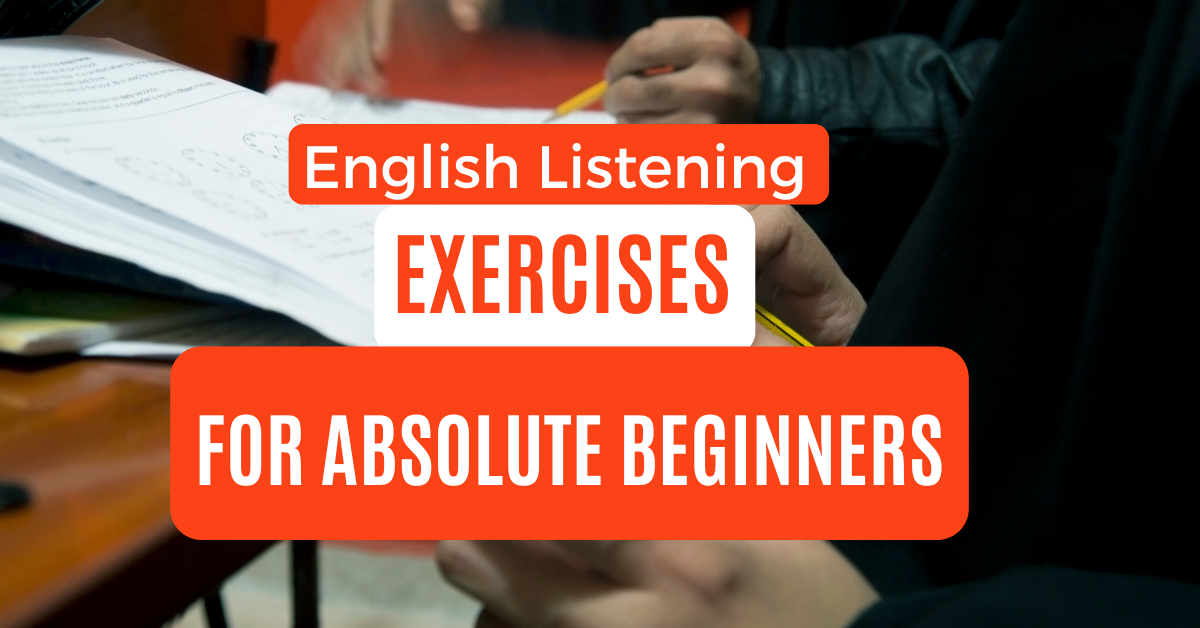
Can’t Understand Spoken English? Try These Easy English Listening Exercises
Introduction:
Those who are absolute beginners in English often come across the same problem- they don’t quite understand what others are saying. To deal with this, they must strengthen their English listening skill, which can be overwhelming for many.
Here’s the good news! With the right tools and practices, you can easily hone English listening skills faster than you think. In this blog post, I’ll walk you through practical and effective English listening exercises designed specifically for beginners. These English listening exercises will help you gain confidence in understanding spoken English.
Let’s start your English listening journey today!
Why Is English Listening Important?
English learning, actually, starts with English listening. English listening skill is considered one of the fundamental skills to learn English language. Those who listen better can learn English faster. Also, their retention power is stronger than that of others.
For English learners, listening is crucial because they:
- learn correct pronunciation and sentence rhythm
- pick up commonly used expressions and grammar naturally
- build confidence in real-life conversations
- It improves your speaking, too!
Common Challenges Faced by Beginners
Below are the challenges faced by beginners trying to understand spoken English:
- Fast speech: Native speakers speak faster
- Connected speech: Words sound like blending together
- Accents and slang: Variations make it confusing
- Silent letters and tricky pronunciation: Words don’t always sound as they’re spelled
- Lack of vocabulary: They are not familiar with many words
But the good news is—every challenge can be solved with the right approach. Let’s look at the best English listening exercises to build your skills.
The Golden Rule: Listen Every Day
If you want to improve your English listening, you need to listen to English daily. Even just 15–20 minutes a day can make a big difference. The key is consistent and focused practice. You can listen to a simple speech, a song, or a podcast. For better understanding, refer to subtitles.
English Listening Exercises for Absolute Beginners
Let’s break down effective exercises into easy levels for beginners. These activities are simple, fun, and can be done at home with free resources.
1. Word Recognition Practice
Goal: Understand and recognize common English words when spoken.
How to Practice:
- Listen to slow recordings of individual words
- Use flashcards with pictures
- Match spoken words to images
Example:
- Audio: “Euphoria”
- Choose from 3 pictures: a girl sleeping, a girl madly jumping, a girl eating food
Tips:
- Repeat each word 3 times
- Speak the word after hearing it
- Create your own picture dictionary
2. Sentence Matching and Translation
Goal: Understand simple English sentences.
How to Practice:
- Listen to a short sentence
- Match it to the correct translation (in your native language)
- Use pictures to support understanding
Example:
- Audio: “The girl is reading a book.”
- Match it with: “लड़की किताब पढ़ रही है” (Hindi)
3. Listen and Repeat (Shadowing Technique)
Goal: Improve pronunciation, rhythm, and listening comprehension.
How to Practice:
- Listen to a sentence
- Pause
- Repeat exactly what you heard
- Focus on matching the tone, stress, and rhythm
Example:
- Audio: “Good morning. How are you today?”
- You repeat: “Good morning. How are you today?”
Pro Tip: Record yourself and compare with the original.
4. Fill in the Blanks (Dictation Exercise)
Goal: Train your ears to catch specific words.
How to Practice:
- Play a short audio clip
- Write down what you hear
- Leave blanks for words you don’t catch
- Replay and try to fill the blanks
Example:
- Audio: “She is going to the _______.”
- Answer: “market”

Answer Key
- meeting
- breakfast
- train
- breeze
- passenger
- morning
- café
- note
- conference
- monthly
- presentation
- satisfied
- productive
5. Listen to Short Conversations
Goal: Understand everyday dialogues.
How to Practice:
- Listen to beginner English conversations
- Use subtitles first, then try without
- Practice repeating both sides of the dialogue
Topics:
- Introducing yourself
- Shopping
- Asking for directions
- Ordering food
Bonus Exercises for Extra Practice
6. Listen to English Songs
Start with slow and clear songs. Use subtitles and sing along!
Examples:
- “wise men say” by Elvis Presley
- “Hello” by Adele
7. Watch English Cartoons
Cartoons use slow, simple English. Perfect for beginners.
Examples:
- Peppa Pig
- Doraemon
Watch on YouTube with subtitles.
8. Watch English with Subtitles (Then Without)
Step 1: Watch a video with subtitles
Step 2: Watch the same video again with English subtitles
Step 3: Watch again without subtitles
Repeat this 3-step cycle with each video.
Daily Listening Routine (20-Minutes Only!)
Here’s a simple plan you can follow every day:
5 Minutes – Word recognition
5 Minutes – Sentence listening with picture matching
5 Minutes – Listen and repeat a short video
5 Minutes – Watch a short cartoon or dialogue scene
Stick to this routine for 30 days and see the difference!
How to Track Your Progress
- Keep a notebook
- Write down 5 new words you hear each day
- Note which sentences were difficult
- Try again the next day and see if you improved
Tips to Improve English Listening Faster
- Listen to Slow English First: Avoid the content which is fast paced in the beginning.
- Repeat Often: Repetition is essential for good retention.
- Use Subtitles: Watch or listen with subtitles first, then without.
- Speak What You Hear: Speaking what you listen helps improving listening skills.
- Don’t Translate Every Word: Avoid translation and focus on overall meaning.
- Watch One Video Many Times: Don’t rush to new content. Repeat until you understand.
Frequently Asked Questions (FAQs)
1. Why is English listening important for beginners?
English listening is the foundation of learning the language. When you improve your English listening skills, you understand conversations, movies, podcasts, and even everyday instructions more easily. It also helps you improve pronunciation and speaking fluency.
2. How can I start English listening practice if I’m an absolute beginner?
Start with slow and simple English listening exercises for beginners, such as short audio clips or dialogues. Many English listening apps provide beginner-friendly lessons. Repeat the audio, focus on key words, and don’t worry if you don’t understand everything at once.
3. What are English listening exercises with answers, and why are they useful?
These are practice audios followed by comprehension questions and answers. English listening exercises with answers allow you to check your understanding immediately, which makes learning active and effective.
4. How often should I do English listening practice audio?
Daily practice is best. Even 10–15 minutes of listening every day can make a big difference. Consistency is more important than long study sessions.
5. Can I improve my English listening skills without living in an English-speaking country?
Yes! With the internet, you have access to plenty of English listening practice for beginners, from YouTube videos and podcasts to audiobooks and English listening apps. You don’t need to be in an English-speaking country to practice daily.
6. What kind of English listening activity works best for absolute beginners?
Simple activities like listening to short stories, daily conversations, or easy news reports are ideal. Choose English listening exercises that include both audio and text so you can listen and read together.
7. How can I stay motivated while doing English listening exercises?
Pick topics that interest you. For example, if you like sports, find English listening practice audio about sports. Set small goals, such as understanding 3 new words per day. Celebrate progress instead of worrying about mistakes.
8. Should I use subtitles or transcripts while listening?
Yes, especially at the beginning. Using subtitles or transcripts along with English listening exercises for beginners helps you connect sounds with written words. Slowly, you can try listening without them to test your skills.
9. Are English listening apps really helpful?
An English listening app is a great tool because it offers structured lessons, exercises, and practice audios. Many apps also have interactive English listening activities, making the process fun and engaging.
10. How long will it take to improve my English listening skills?
It depends on your practice and consistency. With regular English listening exercises and daily audio practice, most beginners notice improvement in a few weeks. Remember, patience and regular effort are the keys to success.
11. I can read well, but can’t understand spoken English. Why?
Reading and listening use different brain processes. You need listening practice to train your ears.
12. Can I improve my English listening without a teacher?
Yes! With the internet, apps, and YouTube, self-study is possible—but for this, patience and persistence are required!
Conclusion:
Improving your English listening is like learning to ride a bicycle. You may fall at first, but if you keep trying, it gets easier.
Start with easy content, follow the exercises, and listen every day. Use fun materials like cartoons and songs. Repeat until you feel confident. Don’t worry about mistakes—they are part of learning.
If you stay consistent, you’ll start understanding English naturally—without even realizing it.
So start today. Pick a short video, grab your notebook, and press play. Your journey to fluent English listening begins now!
Share Your Thoughts
Which exercise are you starting with today? Let me know in the comments.


Interesting read!
Thank you!
Really enjoying this article! Great insights.
Thank you!
Interesting analysis! Solid insights here!
Thank you! Keep coming back for more. Also, please leave a review on trustpilot.
Interesting analysis! Solid points!
Thank you for your feedback!